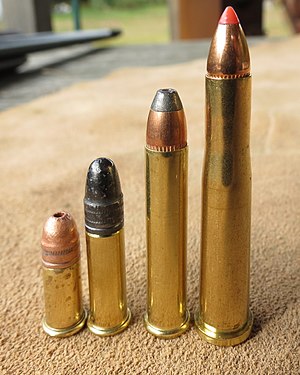.22 Hornet
| .22 Hornet | ||||||||||||||||||||||||
|---|---|---|---|---|---|---|---|---|---|---|---|---|---|---|---|---|---|---|---|---|---|---|---|---|

Left to right: a .22 Short, .22 LR, .22 Winchester Magnum, and a .22 Hornet with Hornady 35 gr (2.3 g) VMax bullet
|
||||||||||||||||||||||||
| Type | Rifle | |||||||||||||||||||||||
| Place of origin | United States | |||||||||||||||||||||||
| Service history | ||||||||||||||||||||||||
| In service | 1930–present | |||||||||||||||||||||||
| Used by | USAAF | |||||||||||||||||||||||
| Wars | World War II | |||||||||||||||||||||||
| Production history | ||||||||||||||||||||||||
| Designer | Townsend Whelen / G. L. Wotkyns | |||||||||||||||||||||||
| Designed | 1920s | |||||||||||||||||||||||
| Manufacturer | Winchester | |||||||||||||||||||||||
| Produced | 1930–present | |||||||||||||||||||||||
| Variants | .22 Hornet Ackley, .22 K-Hornet | |||||||||||||||||||||||
| Specifications | ||||||||||||||||||||||||
| Parent case | None | |||||||||||||||||||||||
| Bullet diameter | .224 in (5.7 mm) | |||||||||||||||||||||||
| Neck diameter | .243 in (6.2 mm) | |||||||||||||||||||||||
| Shoulder diameter | .276 in (7.0 mm) | |||||||||||||||||||||||
| Base diameter | .298 in (7.6 mm) | |||||||||||||||||||||||
| Rim diameter | .350 in (8.9 mm) | |||||||||||||||||||||||
| Rim thickness | .065 in (1.7 mm) | |||||||||||||||||||||||
| Case length | 1.403 in (35.6 mm) | |||||||||||||||||||||||
| Rifling twist | 1-14 | |||||||||||||||||||||||
| Primer type | small rifle | |||||||||||||||||||||||
| Ballistic performance | ||||||||||||||||||||||||
|
||||||||||||||||||||||||
|
Test barrel length: 24 inches Source(s): Hodgdon Powder Company |
||||||||||||||||||||||||
The .22 Hornet or 5.6×35mmR is a vermin, small-game, predator, and competition centerfire rifle cartridge commercially introduced in 1930. It is considerably more powerful than the .22 WMR and the .17 HMR, achieving higher velocity with a bullet twice the weight. The Hornet also differs very significantly from these in that it is not a rimfire but a centerfire cartridge. This makes it handloadable and reloadable, and thus much more versatile. It was the smallest commercially available .22 caliber centerfire cartridge until the introduction of the FN 5.7×28mm.
The .22 Hornet fills the gap between such popular varmint/predator cartridges as the .22 WMR and the .223 Remington. In regard to muzzle velocity, muzzle energy and noise, it is well suited to vermin and predator control in relatively built-up areas.
Prior to the development of the modern .22 Hornet, there was a conceptually similar but physically different cartridge by the same name invented in the 1890s by Reuben Harwood (nicknamed "Iron Ramrod)", sometimes called the ".22 Harwood Hornet" to avoid confusion, as the two rounds are not compatible. Harwood's cartridge was formed by necking down .25-20 Winchester brass to .22 caliber, and was initially loaded with black powder.
The modern .22 Hornet's ancestry is generally attributed to experiments done in the 1920s using the black-powder .22 WCF at Springfield Armory.Winchester adopted what had so far been a wildcat cartridge in 1930, producing ammo for a cartridge for which no commercially made guns yet had been built. It was not until 1932 that any company began selling commercially made guns for the cartridge.
...
Wikipedia
